Apocalypse Laos: America Loses the Laotian Civil War to the Communists
American Proxy Wars: Korea and Vietnam is designed to feature Foreign Broadcast Information Service (FBIS) coverage of those two countries, but this database can be used for much more than researching the Korean and Vietnam wars. For example, let’s take this new Twentieth-Century Global Perspectives database “off-label” and see what it can tell us about America’s proxy war in Laos.
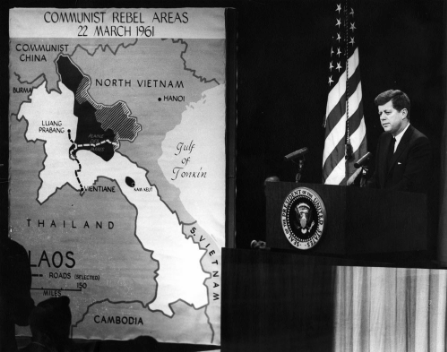
Laos itself was a creation of French colonialism in the late nineteenth century, and achieved independence in 1954 following the First Indochina War. The Pathet Lao, a communist organization, came into being in the early 1950s in opposition to French ambitions in Southeast Asia. The Pathet Lao were similar to the Viet Cong in that they had both political and military aspirations, and the two groups worked closely together. America targeted them both during the Vietnam War when the North Vietnamese Army moved its supply operations into Laos along the Ho Chi Minh Trail.

When Laos became independent in 1954, the Pathet Lao turned its revolutionary focus to the Royal Laotian Army. Thus began the Laotian Civil War which roughly coincided with America’s conflict in Vietnam.
As a hedge against President Eisenhower’s “domino theory” of successive states falling to communist rule, during that period America backed the Laotian monarchy in order to maintain a buffer between communist countries in the region and more pro-Western states such as Thailand. The Soviet Union and North Vietnam backed the Pathet Lao. China had just concluded its own civil war and was increasingly at odds with Soviet communism, so the Soviets became the primary patron of Laos through North Vietnam.
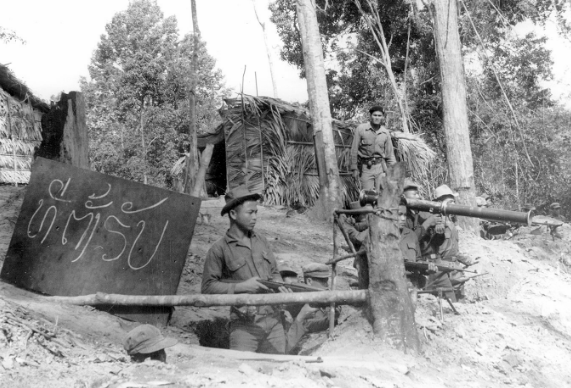
The 1954 Geneva Accords which granted Laos its independence also barred the introduction of foreign troops, and the 1962 International Declaration on the Neutrality of Laos reinforced that commitment. Yet communism was on the rise in Laos, a trend that worried the United States. And the North Vietnamese violated Laotian neutrality with impunity.
Since overt intervention was prohibited, America turned to covert means—promulgated by the U.S. Central Intelligence Agency (CIA). Writing from Hamburg in West Germany, nearly on the border of a communist state, the news magazine Der Spiegel [The Mirror] described the CIA’s involvement in Laos in relatively objective terms:
As early as 9 years ago, the general staff in Washington had calculated that the United States could keep the country [i.e., Laos] free of communists only if the President were prepared to send 300,000 GIs, use atomic weapons, and risk a 10-year war and possible intervention by China. Indeed Washington did not get involved officially, yet the U.S. intelligence service CIA, entrusted with Operation Laos, acted with the silent approval of the White House, the State Department, and the Pentagon.
At first the Americans merely flew reconnaissance missions over Laos, first without then with, fighter protection. Later they began work on the ground. Under the cover of the Agency for International Development (AID), the U.S. authority for development assistance, the CIA recruited a secret army of about 36,000 men from among the bellicose Meo tribes and prepared it for civil war.
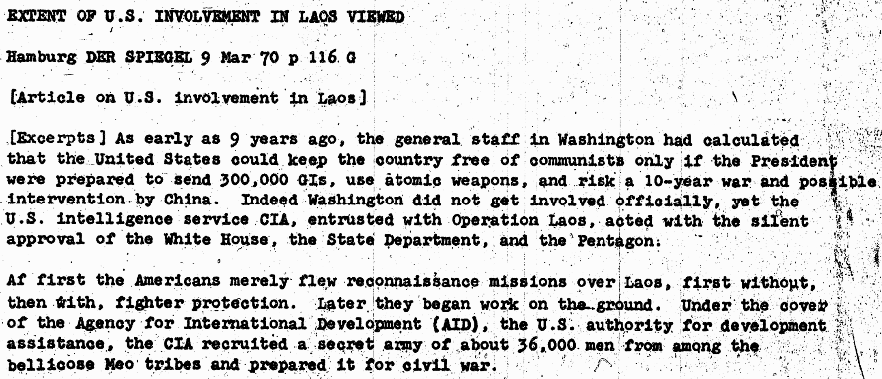
Ostensibly the war was run from the U.S. State Department by William H. Sullivan, who served as Ambassador to Laos from December 1964 to March 1969. Hanoi’s communist VNA International Service was not nearly so detached as the West Germans, above, in its description of America’s projects in Southeast Asia:
The paper [Nhan Dan] recalled that many commandos of the Nguyen Khanh clique had been smuggled into central and lower Laos. Many war-seeking and provocative acts of the U.S. imperialists against the DRV were staged from Laos. The recent sending of William Sullivan, assistant to General Taylor in Saigon, as U.S. ambassador to Laos as well as the arrival of Phoumi Nosavan in Saigon lie in the U.S. plan to prepare for the expansion of war in Indochina.

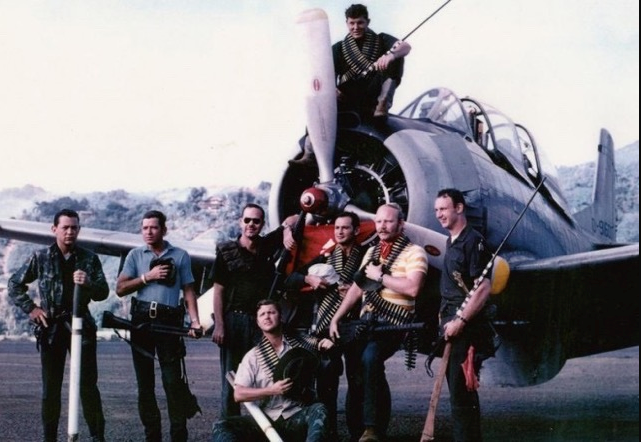
The undeclared war in Laos became known in Washington back-channels as “The Secret War.” Initially the CIA tried to keep the Laotian monarchy in power. When this proved to be impossible, America supported Lao, Hmong and Meo guerrillas fighting the Pathet Lao.
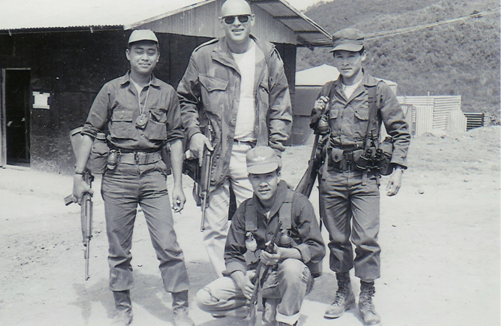
The most prominent indigenous military commander was a Hmong general named Vang Pao. He would eventually lead over 30,000 of his countrymen in battle; by the end of the war at least that many Hmong would be killed or missing in action.
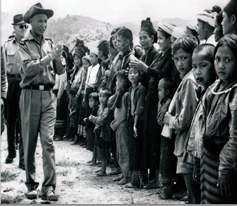
The Pathet Lao News Agency was not so clandestine as to miss an opportunity to quote the international press in evidence against the CIA’s collaboration with Vang Pao:
The U.S. paper INTERNATIONAL HERALD TRIBUNE on October 27, 1969 admitted that the U.S. Central Intelligence Agency has been organizing, training, equipping, and commanding the U.S.-fostered Vang Pao bandits since the early 1950s.
It also disclosed that the Vang Pao bandits have borne the brunt of the fighting during the illegal nibbling attacks on the Plain of Jars-Xieng Khouang region. It said that the Vang Pao bandits were armed, equipped, fed, paid, guided strategically and tactically, and often transported into and out of action by the United States.

Much of that transportation was also underwritten by the CIA, whose legitimate commercial airline, Civil Air Transport, had an affiliate called Air America whose operations were largely in support of clandestine military and logistical needs in the region. Air America employed retired or re-assigned military pilots, and had relationships within the defense establishment to get whatever aircraft their missions required. Moscow’s Radio Peace and Progress described Air America’s covert mission as an open secret:
World public opinion has received with indignation new facts about the impudent imperialist intervention of the United States in the internal affairs of Laos. [passage indistinct] It has been established that Air America aircraft transport arms and ammunition for the punitive detachments of U.S. troops operating in the Laotian mountains. Thus, Air America, created and financed by the CIA, is participating in operations aimed at crushing Laos’ sovereignty.
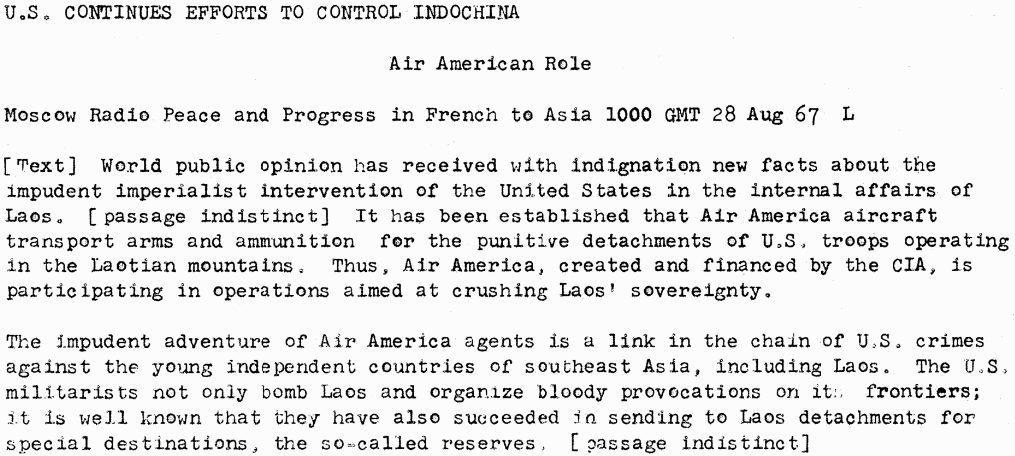
![Air America resupplying a Thai position on the Plaine des Jarres [Laos]. VA060470, Michael Ingham Collection, The Vietnam Center and Archive, Texas Tech University Laos 11.png](/sites/default/files/blog/Laos%2011.png)
Part of the CIA’s strategy was to force the North Vietnamese to divert troops to Laos that would otherwise be fighting Americans in Vietnam. In this much they succeeded, although at a great cost. Laos was heavily bombed, and still presents a challenge for the disposal of unexploded ordnance. East Germany’s Neues Deutschland [New Germany] was ecumenical in its coverage, quoting the New York Times as verifying America’s massive bombing campaign:
In this successor state to the former French Indochinese colonial empire, the United States also applies the notorious “scorched earth tactics.” The bombing terror, increased considerably in recent months, causes sacrifices and misery especially among the population. Up to 300 planes drop their bombs daily on towns and villages in the liberated area. Increasingly, poisonous substances are sprayed for “defoliation of the jungle” and even B-52 bombers of the Strategic Air Force stationed on Guam are flying terrorist attacks.
The New York TIMES reported in early December that “the United States decided to increase air attacks on communist targets in southeast Laos. According to reliable reports, missions of this kind were carried out by F4-C and Thunderchief F-105 planes.” About the time of this report, the Pathet Lao forces had already destroyed 200 U.S. planes.
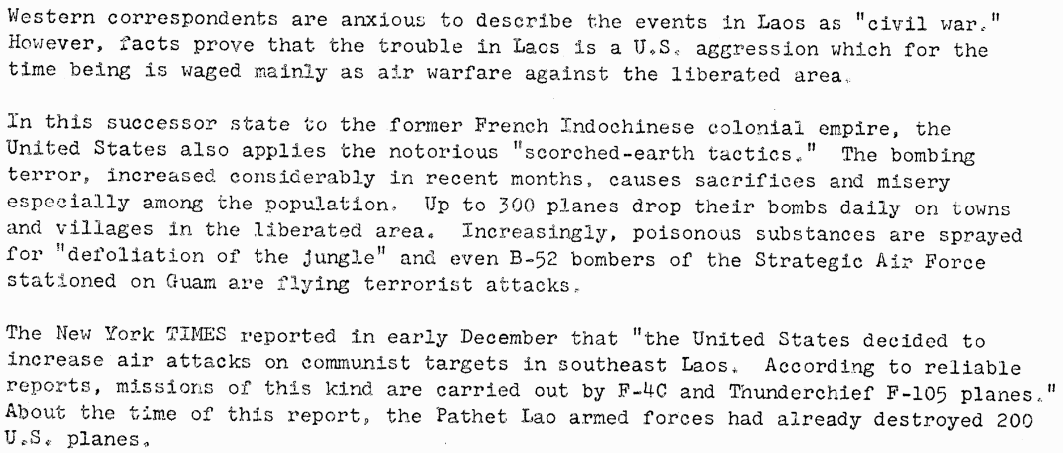
Even in 1969, well before the Vietnam War actually ended, there was “fear of another Vietnam” as the truth of America’s role in the Laotian Civil War became more broadly known in America. As the following excerpt comes from Moscow’s Domestic Service broadcast to a Russian-speaking audience, it’s interesting that the Russians did not apply the lessons learned from America’s failures in Vietnam and Laos to their own efforts to pacify the separatist elements in Chechnya.
Washington has long demanded absolute secrecy concerning its interference in the internal affairs of Laos, a country (? on par with Vietnam) [neposredstvenno sootvetstvuyshchiy s Vietnamom] where the United States has waged open aggression for many years. Suffice it to state that in answer to the American public’s insistent demands to know how many Americans are in Laos, who and what their tasks are, representatives of U.S. officials give ridiculous answers.
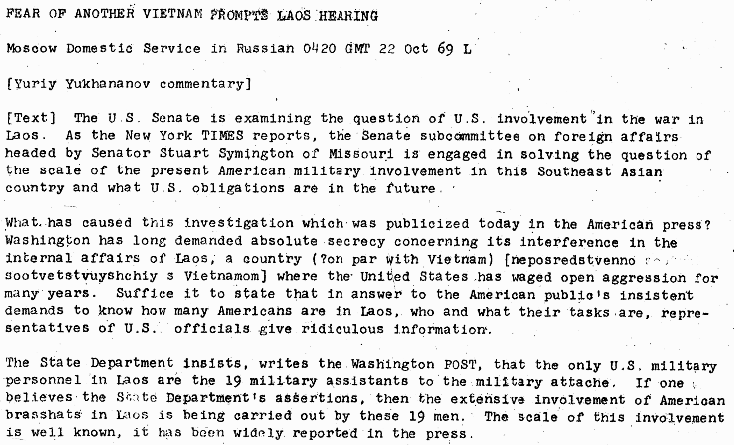
The guerrillas fighting on America’s behalf had no official status when the war ended. Some were resettled, but many more were persecuted or languished in refugee camps in Thailand. Many Hmong were resettled in Minnesota. General Vang Pao and his family were resettled in Montana, and later moved to California where he died in 2011.
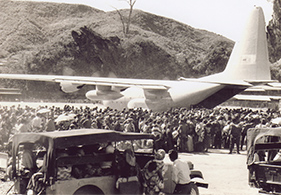
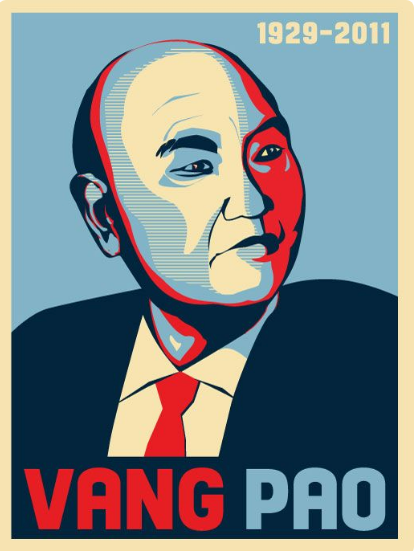
For more information about American Proxy Wars, please contact Readex Marketing.



